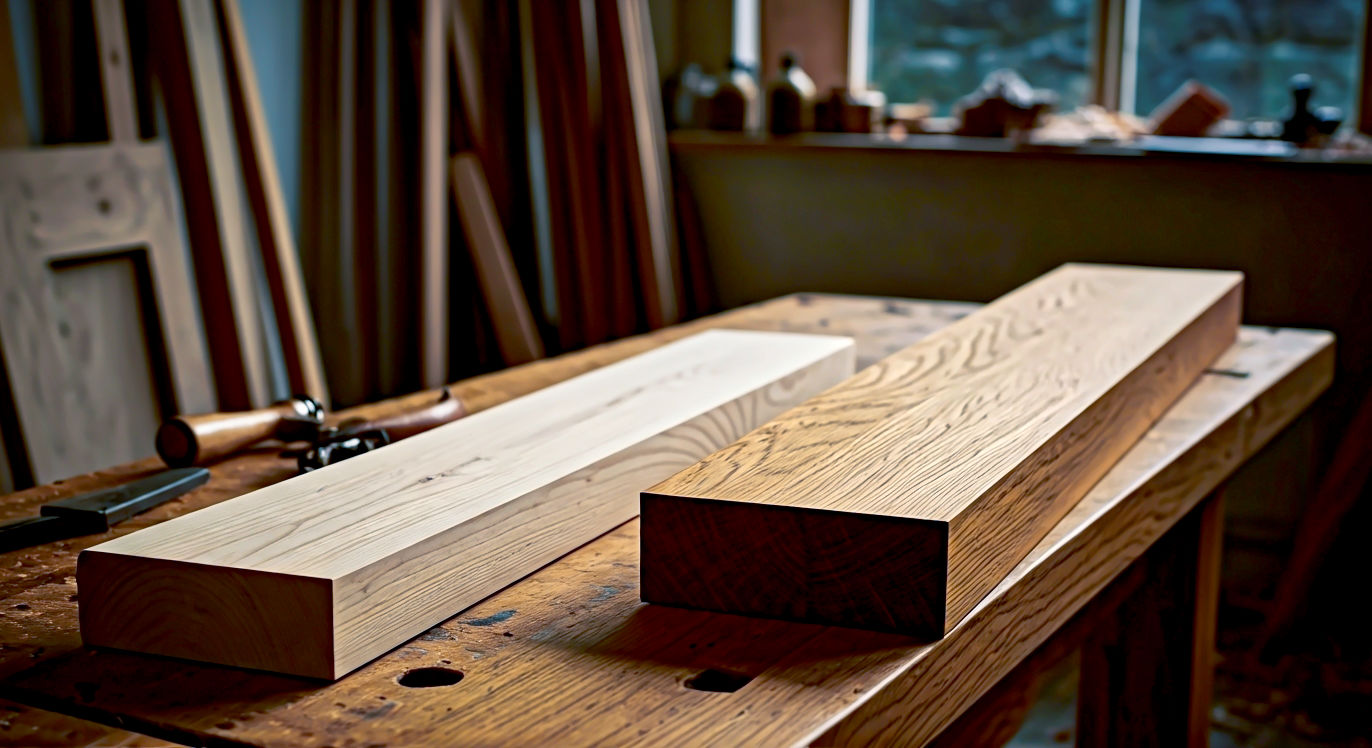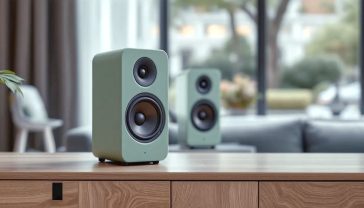The Guide to British Woods: From Acorns to Architraves
The ultimate guide to UK hardwoods and softwoods. We explain the difference, profile key British trees, and give practical tips for choosing sustainable timber.

This post may contain affiliate links. If you make a purchase through these links, we may earn a commission at no additional cost to you.
Walk into any B&Q on a Saturday morning and you’ll see them: towering stacks of pale, knotty planks in the timber aisle. Run your hand over your kitchen table, the sturdy oak one that’s seen countless Sunday roasts. Think of the creak of an old floorboard in a country pub, or the solid clunk of a church door. Wood is everywhere in Britain. It’s the backbone of our homes, the material of our furniture, and a silent witness to our history.
But if you’ve ever felt a bit lost trying to tell your ash from your elm, you’re not alone. The world of wood can seem complicated, a craft reserved for bearded carpenters in dusty workshops. The good news? It’s much simpler than you think. At its heart, it all boils down to two great families: hardwoods and softwoods.
And here’s the first secret: the names are a bit of a fib. It’s not really about how hard or soft the wood is. It’s a story about trees, leaves, and seeds—a botanical drama that plays out in our forests and ends up in our homes. In this guide, we’ll unravel it all. We’ll explore the real difference between hardwoods and softwoods, take a stroll through Britain’s woodlands to meet the local celebrities (from mighty oak to humble pine), and give you the practical knowledge to choose the perfect timber for any job. So, grab a cuppa, and let’s talk wood.
The Great Misconception: What Really Divides Hardwood and Softwood?
Most people think the difference is simple. Hardwoods are hard, softwoods are soft. Right? Wrong.
It’s the most common mistake people make, and it’s completely understandable. But it can lead you astray. For example, Balsa wood, famously used to make model aeroplanes, is incredibly light and soft. You can dent it with a fingernail. Yet, botanically, it’s a hardwood. On the other hand, Yew, a softwood from a coniferous tree often found in British churchyards, is incredibly hard and durable.
So, if it’s not about density, what is it about? The real difference lies in how the trees reproduce. It’s all about botany.
The Botanical Truth: It’s All in the Seeds
Every tree in the world belongs to one of two groups: angiosperms or gymnosperms. It sounds a bit technical, but the idea is simple.
Hardwoods are Angiosperms
Hardwoods come from angiosperm trees. Think of an oak, a beech, or an apple tree. What do they have in common?
- They have broad leaves, not needles.
- They are usually deciduous, meaning they lose their leaves in the autumn.
- Their seeds are enclosed in a protective case. This could be a fleshy fruit (like a cherry), a nut (like a walnut), or a tough casing (like the acorn of an oak tree).
These are the trees that give our countryside its glorious autumn colours. In Britain, our classic native hardwoods include oak, ash, beech, elm, and sycamore.
Softwoods are Gymnosperms
Softwoods, on the other hand, come from gymnosperm trees. Think of a pine or a fir tree—the kind you decorate at Christmas.
- They usually have needles instead of broad leaves.
- They are typically evergreen, keeping their needles all year round.
- Their seeds are ‘naked’. They don’t hide inside a fruit. Instead, they are dropped from cones, exposed to the elements.
These are the conifers that create vast, scented forests, especially in places like Scotland. Our most common softwoods include pine (like Scots Pine), spruce, larch, and fir.
A Look Down the Microscope: A Tale of Two Structures
The way hardwoods and softwoods grow also gives them a different internal structure, which affects how they look and behave. Imagine wood is a block of flats for water, carrying it from the roots up to the leaves.
In hardwoods, the water travels up through special, wide tubes called vessels or pores. If you look at a slice of oak under a microscope, you can see these pores clearly. They are what give hardwoods their rich, interesting grain patterns. Think of the beautiful swirls in a piece of ash or the deep, textured lines in oak.
Softwoods have a simpler system. They don’t have these big pores. Instead, they use smaller cells called tracheids to do everything—transport water and provide structural support. This simpler, more uniform structure is why softwoods often have a very straight, even grain and are generally lighter than hardwoods.
At-a-Glance Comparison
| Feature | Hardwoods | Softwoods |
|---|---|---|
| Tree Type | Angiosperm (Flowering plants) | Gymnosperm (Cone-bearing plants) |
| Leaves | Broad leaves | Needles or scales |
| Life Cycle | Usually deciduous (lose leaves) | Usually evergreen |
| Seeds | Enclosed in a fruit or nut | ‘Naked’ seeds in cones |
| Structure | Complex, with visible pores | Simpler, no pores |
| Grain | Often rich, varied, and decorative | Often straight and uniform |
| Common UK Examples | Oak, Ash, Beech, Elm, Sycamore | Scots Pine, Larch, Spruce, Douglas Fir |
| General Cost | Higher | Lower |
| Growth Speed | Slower | Faster |
A Stroll Through Britain’s Woodlands: Meet the Trees
Now that we know the difference, let’s get to know some of the most important woods you’ll find in the UK. Some are true natives that have shaped our history, while others are hardworking immigrants that form the backbone of our construction industry.
The Great British Hardwoods
These are the aristocrats of the timber world. Slower growing and often more expensive, they are prized for their strength, durability, and beauty.
Oak: The King of the Forest
If Britain had a national tree, it would be the oak. It’s a symbol of strength and endurance, woven into our history.
- History: The Royal Navy’s warships—Nelson’s ‘wooden walls’—were built from oak. The magnificent hammer-beam roof of Westminster Hall is made from it. Tudor houses are famed for their black oak frames. It’s the wood of kings and cathedrals.
- Properties: Oak is incredibly strong, heavy, and durable. It’s also highly resistant to rot and insects, which is why it lasts for centuries.
- Best For: High-quality furniture, flooring, kitchen worktops, garden structures, and barrels for ageing whisky and wine. If you want something to last a lifetime (or several), choose oak.
- The Look: A beautiful golden-brown colour with a distinctive, coarse grain. You know it when you see it.
Ash: The Flexible Friend
Ash is the athlete of the woodland. It’s tough but flexible, prized for its ability to absorb shocks without splintering.
- History & Culture: In folklore, it was a tree of healing and magic. In practical terms, it was the go-to wood for anything that needed to be strong but not rigid. Sadly, our native ash is under serious threat from a disease called ash dieback, which is devastating woodlands across the country.
- Properties: Its standout feature is its shock resistance. It’s strong for its weight and bends beautifully.
- Best For: Tool handles (think hammers and axes), sports equipment (snooker cues, oars, and Irish hurleys), and elegant, modern furniture.
- The Look: A lovely creamy-white to pale brown colour, usually with a straight, smooth grain.
Beech: The Clean-Cut Classic
Beech is a hard, strong wood that feels smooth and gentle to the touch. It’s a wood for indoors, a reliable and clean-looking choice.
- Properties: It’s very hard and heavy, but it isn’t durable outdoors. Its superpower is that it can be steam-bent into elegant curves without breaking. It also has a fine, tight grain that’s great for detailed work.
- Best For: Furniture, especially chairs. The classic Windsor chair is a masterpiece of steam-bent beech. It’s also perfect for kitchen items like chopping boards, utensils, and worktops because it doesn’t taint the taste of food. You’ll also find it used for children’s toys.
- The Look: A pale, creamy wood, sometimes with a pinkish hue. The grain is fine and straight, giving it a calm, uniform appearance.
Sycamore: The Musician’s Choice
A member of the maple family, sycamore is a pale, interesting hardwood with a secret talent.
- Properties: It’s hard, strong, and has a very fine texture. Like beech, it’s food-safe.
- Best For: Kitchenware is a common use, but its most glamorous role is in making musical instruments. The back and ribs of violins, violas, and cellos are often made from sycamore, especially pieces with a beautiful, wavy grain known as ‘flamed’ or ‘fiddleback’ sycamore.
- The Look: A bright, creamy-white wood with a natural silky shine.
Britain’s Hardworking Softwoods
Softwoods are the engine of the timber industry. They grow faster than hardwoods, making them more affordable and sustainable for large-scale use. They are the wood you’ll find in every DIY store, used for everything from roof joists to garden fences.
Scots Pine: The Highland Hero
This is our only truly native pine, a rugged survivor that defines the landscape of the Scottish Highlands.
- Properties: It’s a relatively lightweight wood that’s easy to work with. Its main feature is its knots, which give it a rustic, country feel. It can be prone to dents and scratches.
- Best For: It’s a jack-of-all-trades. It’s used for construction timber (joists, roof trusses), furniture (especially rustic or painted pieces), doors, and flooring. It’s the classic wood for home projects.
- The Look: A distinctive pale yellow or reddish-brown with prominent darker knots.
Larch: The Tough Softwood
Larch is a bit of an oddball. It’s a conifer, so it’s a softwood, but it’s one of the few that is deciduous (it loses its needles in winter). It’s also naturally tough.
- Properties: Larch is one of the most durable softwoods. It’s naturally resistant to rot, thanks to the resin in the wood. This means it can be used outdoors without needing chemical treatments.
- Best For: Anything outside. It’s fantastic for building cladding, decking, fence posts, and garden furniture.
- The Look: A warm, reddish-brown heartwood that weathers to a beautiful silvery-grey over time if left untreated.
Spruce: The Musical Powerhouse
Often imported but now widely grown in UK plantations, spruce (especially Sitka spruce) is prized for its high strength-to-weight ratio.
- Properties: It’s light but very strong and stiff, making it perfect for structural work.
- Best For: Its biggest use is in construction, where it’s known as ‘whitewood’. It’s also a star in the music world, used for the soundboards of guitars, violins, and pianos because it resonates so well. And, of course, it’s our traditional Christmas tree.
- The Look: A creamy white or pale yellow with a fine, straight grain.
Douglas Fir: The Gentle Giant
Originally from North America, this tree is now a key part of British forestry. It grows tall and straight, producing long, clear lengths of high-quality timber.
- Properties: Exceptionally strong for its weight, with a very straight grain. It’s more stable than other softwoods, meaning it’s less likely to warp or twist as it dries.
- Best For: Structural work where strength is critical, like large beams and roof trusses. It’s also used to make plywood.
- The Look: A light reddish-brown colour that darkens over time.
From Forest to Floorboard: The Journey of Timber
A tree in a forest and a plank of wood in a shop are two very different things. The journey between them is a crucial process of felling, sawing, and drying that determines the quality of the final product.
Sustainable Forests: A Green Promise
Gone are the days of clearing forests without a second thought. Today, responsible forestry is key. When you buy wood, you want to know it comes from a forest that is managed properly, where new trees are planted to replace the ones that are cut down.
How can you be sure? Look for a logo. There are two main international organisations that certify sustainable forestry:
- FSC (Forest Stewardship Council): This is the gold standard. The FSC logo means the wood comes from a forest managed to the highest environmental and social standards.
- PEFC (Programme for the Endorsement of Forest Certification): This is another widely recognised certification that ensures timber comes from sustainably managed sources.
Buying wood with an FSC or PEFC logo is the single most important thing you can do to ensure you’re making an environmentally friendly choice. In the UK, organisations like the Forestry Commission oversee the management of our public forests.
Felling, Sawing, and Seasoning
Once a tree is felled, the log is taken to a sawmill to be cut into boards. The way it’s cut, or ‘converted’, has a big impact on the wood’s grain and stability. The most common method is plain sawing, which is quick and produces little waste. More specialist methods, like quarter sawing, can create a more stable board with a straighter grain, but they are more expensive.
The most critical step, however, is seasoning, which is just a fancy word for drying. A freshly cut log is full of water. If you try to make something from this ‘green’ wood, it will warp, split, and shrink as it dries out naturally. All timber must be seasoned before use.
There are two ways to do it:
- Air Drying: The traditional method. Planks are stacked with gaps between them to let air circulate, and left (often for years) to dry slowly. It’s gentle on the wood but takes a very long time.
- Kiln Drying: The modern method. The wood is placed in a large, heated chamber—like an oven—where temperature and humidity are carefully controlled to dry the wood in a matter of weeks or days. It’s fast and effective, and most of the timber you buy today is kiln-dried.
The Right Wood for the Job: A Practical Guide
Choosing the right wood can feel daunting, but it’s just a matter of matching the wood’s properties to what you need it to do. Let’s break it down with some common projects.
“I’m building a deck in the garden.”
You need a wood that can stand up to the Great British weather: rain, frost, and sun. Durability is key.
- Excellent Choices: Larch is a fantastic natural option. Pressure-treated pine (where preservatives are forced deep into the wood) is a very common and affordable choice. For a high-end, long-lasting deck, a super-durable hardwood like Oak is unbeatable but expensive.
- Avoid: Untreated softwoods like spruce, or indoor hardwoods like beech, which will rot very quickly.
“I want to make a kitchen worktop.”
This needs to be tough, water-resistant (when sealed), and ideally food-safe.
- Excellent Choices: Oak is the classic for a reason—it’s hard-wearing and looks beautiful. Beech is another great option, very hard and easy to keep clean. Sycamore is also a brilliant choice, traditionally used by butchers.
- Avoid: Softwoods like pine will dent and scratch too easily for a busy kitchen.
“I’m building a bookshelf.”
Here, you need something that is strong enough to hold the weight of books without sagging over time, and that looks good in your living room.
- Excellent Choices: Any of the main hardwoods like Oak or Beech will be more than strong enough. A well-built pine bookshelf can also be very effective and is much cheaper, but you might need thicker shelves or more supports to prevent sagging.
- Avoid: Flimsy materials like MDF for long shelves unless they are very well supported, as they are prone to bowing.
A Quick Word on Finishes
Bare wood is beautiful, but it’s vulnerable. A finish—like an oil, varnish, or wax—protects the wood from moisture, dirt, and wear, while also enhancing its appearance.
- Oil (like Danish or Tung oil): Sinks into the wood and gives a very natural, satin look. It’s easy to apply and repair. Great for worktops and furniture.
- Varnish (Polyurethane): Forms a hard, plastic-like film on the surface. It’s very durable and water-resistant. Good for floors and tables that get a lot of wear.
- Wax: A traditional, gentle finish that gives a soft sheen. It needs a bit more care but provides a beautiful, classic look.
The Future of Wood: Smart Timber and Growing Challenges
Wood has been with us for thousands of years, but it’s not standing still. The way we use it is constantly evolving.
Engineered woods are now a huge part of the industry. These are products like Plywood (layers of wood veneer glued together), MDF (Medium-Density Fibreboard, made from wood fibres and resin), and Chipboard. They are made by taking wood apart and sticking it back together in a more stable, predictable form. They make great use of waste wood and are perfect for things like kitchen cabinets and flat-pack furniture.
New technologies like Cross-Laminated Timber (CLT) are even allowing architects to build skyscrapers out of wood. These massive, incredibly strong panels are like plywood on steroids, and they offer a greener alternative to concrete and steel.
But there are challenges, too. Diseases like ash dieback and the effects of climate change pose a real threat to our native woodlands. It has never been more important to support sustainable forestry and the planting of native British trees to ensure our woodlands thrive for generations to come.
A Material for Life
From the humble pine shelf to the majestic oak beam, the story of wood is the story of our lives. It’s a material that is strong yet forgiving, ancient yet modern, practical yet beautiful. Understanding the simple difference between a hardwood and a softwood is the key that unlocks this incredible world. It allows you to appreciate the history in a piece of furniture, to choose the right material for your next project, and to make choices that help protect our beautiful woodlands for the future.
So next time you run your hand over a wooden surface, take a closer look. See the story in its grain. Because whether it started as an acorn or a cone, it has ended its journey as a remarkable material that enriches our world.
Further Reading
For those looking to explore further, these organisations are excellent resources for information on British woodlands, forestry, and sustainable timber:
- The Forestry Commission: The government department responsible for managing and promoting England’s forests.
- FSC UK (Forest Stewardship Council): Learn more about sustainable forestry certification and find FSC-certified products.
- PEFC UK (Programme for the Endorsement of Forest Certification): The UK site for the world’s largest forest certification system.
- The Woodland Trust: The UK’s largest woodland conservation charity, working to protect and create native woodland.
- Royal Forestry Society: A charity dedicated to sharing knowledge on the art and science of woodland management.






